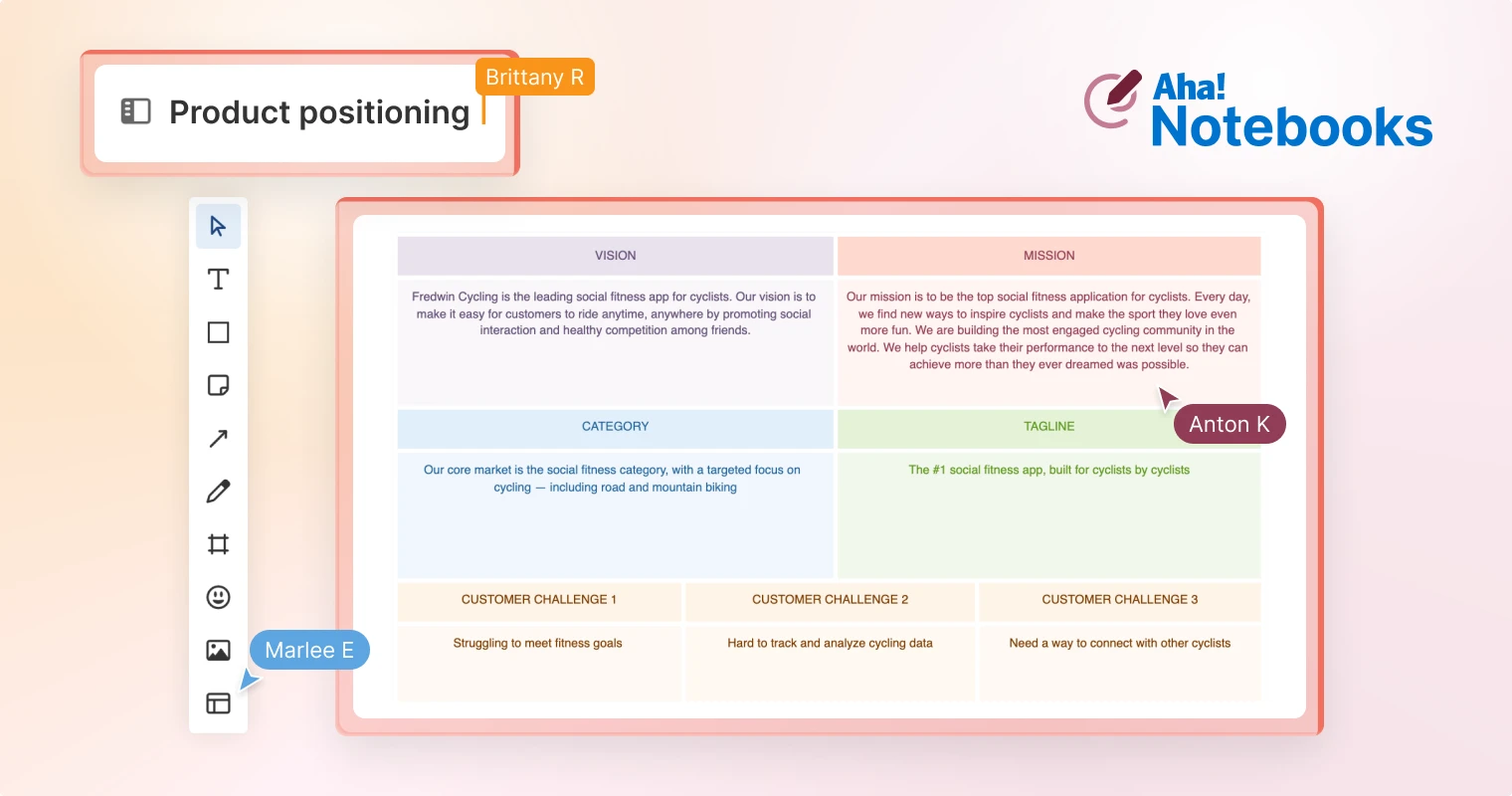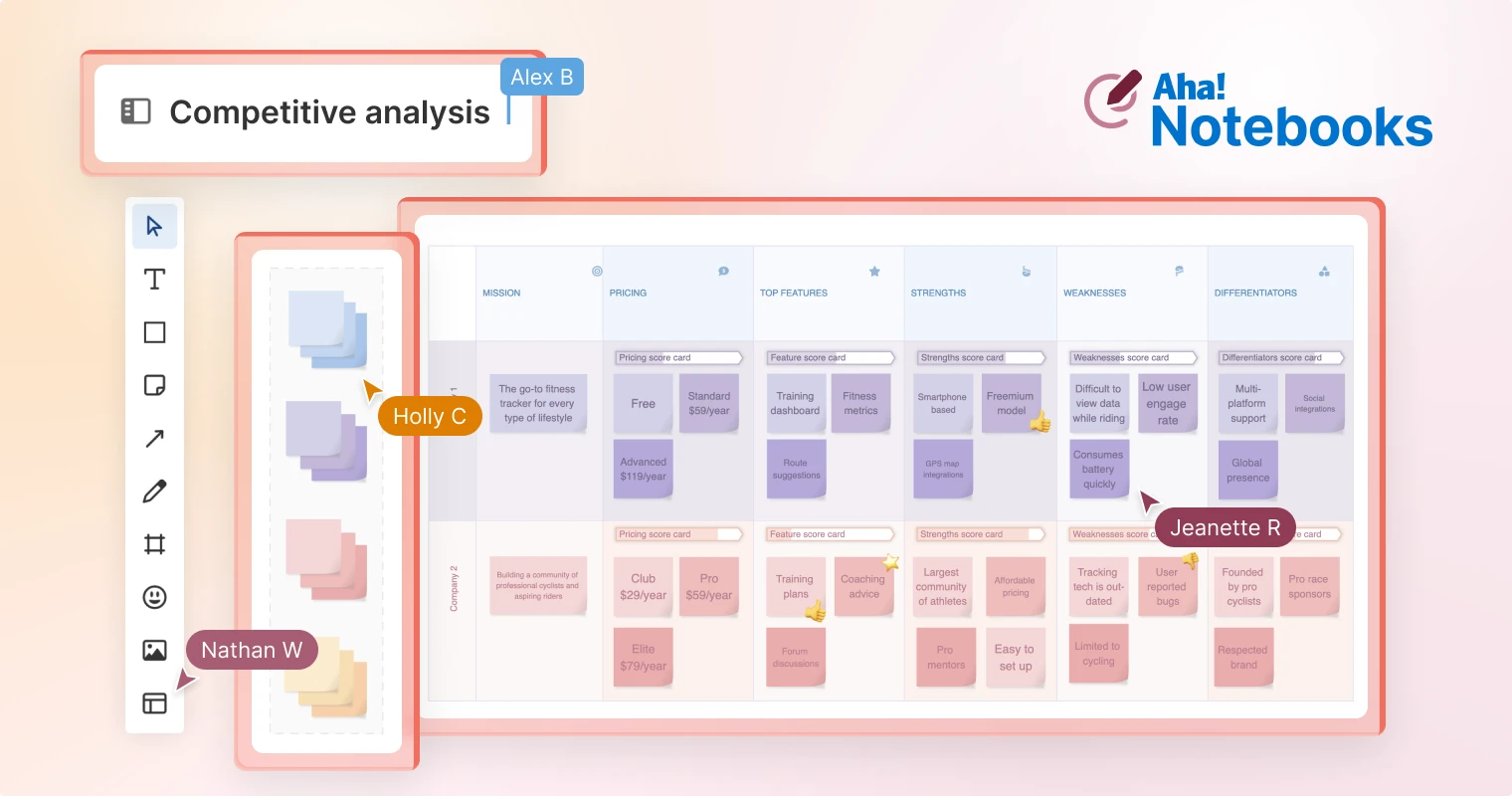
The product positioning template in Aha! software can help you zero in on your product's key benefits and ideal audience.
New product management template: Product positioning
Editor's note: Aha! Notebooks has been split into Aha! Knowledge and Aha! Whiteboards.
Determining how your product stands out could be described as both an art and a science. Product managers need to analyze current and prospective customers, their needs, the features unique to your product, as well as market trends. You weigh all of these inputs to then root your offering in positioning that speaks to the truth of your product and the value it will deliver.
Positioning is a core component of product strategy. It helps you distill who your target audience is, what they need, and how your product can uniquely help.
Product positioning is a strategic exercise typically carried out by product management and product marketing teams. Close collaboration is important — both groups have a unique point of view on the marketplace, other solutions available, and how your own product fits in.
The outcome of the exercise is a product positioning document that helps everyone in the organization understand the real value you provide beyond features and functionality. It becomes the basis for your marketing efforts — influencing everything from pricing decisions to product messaging and campaigns.
Once your positioning is defined, you can write a short positioning statement that emphasizes how you want your product to be perceived: For [group of users] that [need/want], [product] is a [solution] that uniquely solves this by [benefit].
The new product positioning template in Aha! software brings together the building blocks you need to craft your positioning statement — vision, mission, market category, tagline, customer challenges, product differentiators, and more.
This template is built in a collaborative whiteboard so you can invite colleagues to contribute in real time or asynchronously. (Folks can add comments and endorse concepts right within the whiteboard.) Then share the positioning document with the broader organization so people can reference it when needed.
The product positioning template is just one of nearly 100 available in all Aha! Notebooks plans. (Templates are also available in Aha! Roadmaps, Aha! Ideas, and Aha! Develop.) Each template was created by product development experts, is fully customizable, and ready to use right now.
Sign up for a free 30-day trial or log into your Aha! account — then follow the best practices below:
1. Start with foundational elements
Add your company or product vision, mission, market category, and tagline within the template. If you are still defining these elements, use the template to draft options and get feedback from the team.
Next, include the major problems you are trying to solve for customers and how your product uniquely solves them. This would be a good time to revisit customer personas and any market research you have completed.

The digital whiteboard is easy to share with stakeholders to secure feedback.
2. Customize the layout
Feel free to make the template your own. Rearrange the order of the components. Edit the names, categories, and colors. Easily add new sections and remove existing placeholders as you like.

The template comes with nine predefined sections, but do not let that hold you back from making this document your own.
3. Craft your positioning statement
The template includes areas for adding a brand essence and boilerplate statement. You could also include a product positioning statement, using the formula from earlier: For [group of users] that [need/want], [product] is a [solution] that uniquely solves this by [benefit].

The examples above show the brand essence and boilerplate for a fictitious product, Fredwin Cycling.
4. Share with the team
Share what you have drafted for review. When finalized, include your positioning document in a team folder where it is easy to access and reference.

You can organize notes and whiteboards into folders in every Aha! product — creating a central hub the team can access.
Strong product positioning supports your product marketing efforts. It is the foundation of your product's value and the reason you are telling your product story at all.
Be sure to revisit your product positioning regularly (e.g., quarterly or annually) or when significant changes happen in the market. Communicate changes across the organization — it is important for everyone to hone in on what makes your product truly special.
Start a free trial today
Guided templates are available to all Aha! customers. Our suite of product development tools works seamlessly together to help teams turn raw concepts into valuable new capabilities — for customers and the business. Set strategy, crowdsource ideas, spark creativity, prioritize features, share roadmaps, manage releases, and plan development. Sign up for a free 30-day trial or join a live demo to see why more than 700,000 product builders trust our software to build lovable products and be happy doing it.




